A
| Alford Bull |
|---|

Roadside life size naturalistic bronze of an Angus bull on a shallow stone plinth, surrounded by a small area of paving enclosed, on the field side, by a mortared rubble wall with cairn like pillars. |
B
| Burns garden, second Burns bust and Laura Anne memorial stone |
|---|
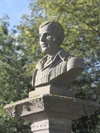
A small civic garden near the Cowie River crossing on the north side of the town centre. |
C
| Coast Festival, Helen Denerley sculpture park |
|---|

As part of the first Coast Festival (23rd-26th May 2008 ). The artist kindly loaned a number of her animalier works. |
D
| Dog statue, Delgatie |
|---|
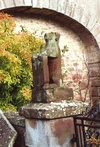
Gatepost ornament, Red sandstone carving of a dog? holding a shield. The late Captain Hay of Delgatie was an inveterate collector and the castle has many decorative elements that are now difficult to attribute to exact dates and provenances. More Information |
| Duke of Richmond statue Huntly |
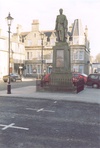
A Victorian portrait statue, inscription reads: Erected as a memorial of Charles Gordon Lennox Fifth Duke of Richmond, by the tenantry of the Lordship of Huntly. More Information |
F
| Fish and chip shop bear |
|---|
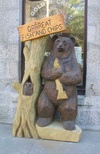
A carved and stained wooden sculpture of a brown bear holding a salmon beside a tree stump with an owl, adorned with a sign. More Information |
| Fyvie stone carved relief figure holding head |
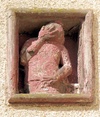
Stone carved figure covering face with hand, the other hand appears to be cradling the head of an infant at waist height. Interpretation is slightly speculative as the stone is quite badly eroded. More Information |
I
| Inverurie War Memorial |
|---|
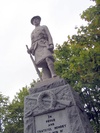
A war memorial of the figurative type with a life size statue of a soldier of a Highland regiment. It commemorates the dead from both World War I & II. It was unveiled on 20 September 1921. It has a tapering rectangular base of rough hewn granite with the name plaques of World War I set in the front and sides. Above the front plaque is carved a wreath behind which are a crossed rifle and sabre. Surmounting it is a statue of a kilted soldier in battledress with a rifle in his right hand resting on its butt. The memorial stands on a three-step base, the centre one of which has the names of the dead from World War II carved into three sides. |
J
| John Brown statue |
|---|
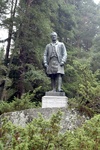
Bronze statue of John Brown, Queen Victoria's gillie, in Highland dress, inscribed with his name on a granite plinth. The inscription on the plinth reads: |
L
| Leopard |
|---|

3d stone carving of a leopard decorating a balustrade. The late Captain Hay of Delgatie was an inveterate collector and the castle has many decorative elements that are now difficult to attribute to exact dates and provenances. More Information |
| Lion Fountain, Drum |

A stone carving of a lion crouched to spring in the middle of a large circular pool. More Information |
M
| Mannie |
|---|
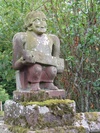
Stone carving, used as a gate post decoration, of a caricatured human figure. The late Captain Hay of Delgatie was an inveterate collector and the castle has many decorative elements that are now difficult to attribute to exact dates and provenances. More Information |
| Memorial to lost lifeboat volunteers |

A life-size bronze statue of an RNLI crewman, cast bronze in the style of heroic realism so much favoured for memorials. More Information |
O
| Old Meldrum Sailor |
|---|
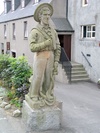
Near life size stone statue of a sailor in period costume holding a pipe in one hand and an anchor in the other. More Information |
P
| Persephone |
|---|

Sculpted millstone grit figure of Persephone, the goddess of the underworld in Greek mythology (abducted by Hades and having to remain with him half of every year because she ate six pomegranate seeds the pomegranate can be seen in the statue's right hand), she is holding a mirror similar to that on the nearby Maiden Stone. |
| Portsoy War Memorial |
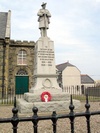
A war memorial of the common 'praying soldier' type. In this case the statue is on top of a tall carved plinth set on a two step base of roughly dressed granite. It is surmounted by a kilted soldier with Glengarry, standing head bowed holding an inverted rifle. It commemorates the dead of both World War I & II. Below the main inscription on the front is a carved wreath. The memorial is surrounded by a small wrought-iron enclosure.It was unveiled 11 November 1923. More Information |
| Post-Modern Finn MacOull |

An example of Frank Bruce's smaller scale work in wood. More Information |
R
| Rob Roy Statue, The Mannie on the Rock, Peterculter |
|---|
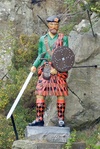
A polychrome carved wood statue in a folk style depicting the popular archetype of the 18th century highland warrior. In tartan plaid armed with broadsword, pistol and targe. Romantically situated on a rock in the side of the burn's gorge. More Information |
S
| Statue of Marshall Keith |
|---|
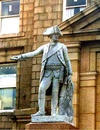
1869. August 16th Marshal Keith monument unveiled by the Earl of Kintore. |
T
| The First Burns Bust |
|---|

Sandstone bust of the poet Robert Burns (b. 25 Jan 1759 d. 21st July 1796, at the age of 37) on a columnar pedestal by Robert Taylor 'Ghosty Bob' a local monumental mason and sculptor (his nickname a result of his work carving many gravestones). This was the first statue of Burns that the artist did. Both works ultimately derive from the 1787 portrait by Alexander Nasmyth (1758-1840). This seems to be regarded as the definitive image and has been used as a source for most of the huge number of later representations, it is certainly more flattering than the portrait painted by Peter Taylor in 1786. |
U
| Unicorn, Delgatie |
|---|
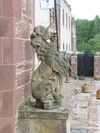
A pair of stone unicorns gaurding the main entrance of the castle. The late Captain Hay of Delgatie was an inveterate collector and the castle has many decorative elements that are now difficult to attribute to exact dates and provenances. More Information |
This content was submitted by external contributors and does not necessarily reflect the views of the University of Aberdeen.
